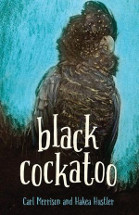Black cockatoo by Carl Merrison and Hakea Hustler

Magabala Books, 2018. ISBN 9781925360707
(Age: 11+) Highly recommended. Mia sees her brother Jy firing stones
at birds with his shanghai. Among the fallen birds there is a
dirrarn black cockatoo, and Mia defiantly gathers it up and wrapping
it in her arms carries it inside to her bedroom hoping to nurse it
to recovery. Her jawiji grandfather scolds her brother and tells him
that he is doing the wrong thing by their culture.
It is never actually stated in the book, but the reader soon
realises that this is an Aboriginal family. Mia's grandparents
retain their culture despite experiences of being rounded up and
losing family to the stolen generations, and they share their
traditional values and cultural beliefs with their family. But Jy is
becoming less respectful and is drawn into cruel and thoughtless
games with other unruly teenagers. Mia is trying to follow a 'both
ways' path, gradually discovering her totemic connection to the
dirrarn, and also studying hard at school.
A deceptively simple story, enhanced by fine-detailed black and
white drawings portraying Australian wildlife and surroundings,
"Black Cockatoo" cleverly draws the reader into a greater
understanding of culture and Country. The teasing humour and banter
between family members is very natural and reveals warm and loving
relationships. Words from the Jaru language and Aboriginal English
are included in the text in a way that makes the meaning clear, so
whilst there is a glossary at the end, there is really no need to
refer to it.
Authors Merrison and Hustler bring their understanding of Indigenous
teenagers growing up in a remote town - Merrison works with young
Aboriginal boys through the Clontarf Academy and Hustler was a high
school English teacher at Halls Creek, Western Australia. Their book
will surely be welcomed by children in those areas, as a welcome
reflection of their culture and experiences, but it is also a story
that children anywhere can relate to, with its themes of exploring
identity and overcoming bullying.
I would recommend this authentic Australian story for all school
libraries, but it would make a particularly appropriate addition to
the collection for the International Year of Indigenous Language,
2019, as it includes living Aboriginal languages in a way that is
very natural and easy to understand and appreciate. Teacher's
notes are available.
Helen Eddy